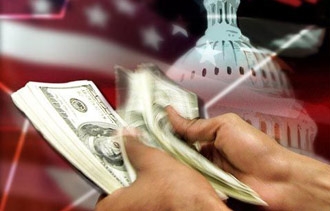by Lawrence Kudlow, Stephen Moore, Arthur B Laffer, and Steve Forbes • Investor’s Business Daily
President Trump and Republican leaders in Congress must act with much more urgency and decisiveness on tax cuts.
In recent weeks the tax cut agenda seems stalled out and the delays and indecision are negatively affecting growth and the stock market. We hear that a tax plan from the White House may not come until the fall and may not even pass Congress until 2018 – if at all.
Is it any wonder that investors are getting jittery? The stock market had priced in much of the anticipated benefits to business, wages and profits, which accounts in no small part for the $3 trillion rise in equity values and the surge in business and consumer confidence after the election. Now the confidence is waning.
Without a tax cut passage in 2017, the odds of Republicans losing the House and Senate in November 2018 are heightened. The economy needs time to respond to the growth hormones from the Trump tax plan. A prosperous economy in 2018 is by far the best way for the GOP to build on its historic victory in 2016.
We reject the idea that a simple, clear, growth-oriented tax cut can’t happen this summer. Barack Obama passed an $830 billion so-called “stimulus bill” within weeks of his new presidency in 2009. Ronald Reagan signed into law at his ranch in Santa Barbara, Calif. his historic tax cut — then the largest in history — by August of his first year in office. The only reason Republicans haven’t made this happen is that the tax cut has not been a priority.
To jump-start the tax debate, we are suggesting a Three Easy Pieces initiative:
- A 15% business tax rate for small and large businesses, with full and immediate expensing for capital purchases.
- A repatriation tax at 10% for foreign earnings brought back to the United States.
- A doubling of the standard deduction from $6,500 to $13,000 for individuals and $13,000 to $25,000 for couples, to put more money into their pockets now and to simplify tax returns.
This plan over 10 years would deliver a $3 trillion tax cut to workers and businesses, and the boost in growth in jobs and output will produce higher-than-predicted increases in federal, state and local tax receipts. A 3%-plus growth rate over the next decade will yield more than $3 trillion in lower deficits at the federal level and almost $1 trillion more in revenues for the states and cities.
We estimate that the business tax cut and full expensing would expand business investment and inflows back into the United States by potentially trillions of dollars in 2018. Instead of jobs, businesses and factories fleeing these shores, the U.S. would become an overnight magnet for capital and jobs. America would be the tax haven.
What does this mean for the middle class? First, the Congressional Budget Office estimates that about two-thirds of the benefits of the corporate tax cut would go to workers in more jobs and wages as businesses reinvest at a faster pace. Faster growth and higher wages would put after-tax revenue in the pockets of average families. Welfare would fall and prosperity would be the new mindset. The increase in the standard deduction would save many middle-class families about $1,500 to $2,000 a year on their taxes and simplify taxes by reducing the need for middle-class families to itemize their deductions.
This “keep it simple” tax plan would scrap three widely believed misconceptions on the way forward on tax policy. The first misconception is that a tax plan should be paid for with offsetting tax increases. No. Revenue neutrality is an inside-the-Beltway trap and will prevent passage of a strong tax cut. We fully recognize that because of arcane budget rules, rejecting revenue neutrality means that the tax cut will not be permanent.
But nothing is permanent in Washington. With 51 votes, the Senate can pass a “temporary” tax cut for that lasts for 10 or 15 years without a single Democrat vote. We would much prefer a powerful tax cut that is “temporary” over a revenue-neutral tax plan that is economically impotent.
The second misconception is that a border-adjustable tax is necessary. Incredibly, the House leaders still have not given up on this wildly unpopular and ill-designed sales tax. This obsession with the border tax is beginning to look like the Pickett’s Charge of tax reform.
Third, is that passing a tax cut now will kill the move for tax simplification and broader reform with lower tax rates and elimination of special interest tax breaks. No. Winning creates its own momentum. A populist campaign to rip up the incomprehensible 60,000-page tax code should be the GOP crusade for 2018 and 2019 – and we will be right behind President Trump in that fight.
Finally, Trump will have to fight for this tax cut not just to take on the liberal class-warfare warriors, but also to get the knee-knockers in his own party off the dime. He should hold a nationally televised address from the Oval Office in the weeks ahead making the case to the American people that a tax cut is vitally important to the economic health, jobs and the vitality of the nation.
This is what Reagan did to push foot-dragging House and Senate members forward on passage of his tax plan in 1981. That changed the course of the American economy for nearly two decades, and Donald Trump can accomplish the same economic resurgence if he acts decisively — and with all due speed.
Forbes, Kudlow, Laffer, and Moore are the founders of the Committee to Unleash Prosperity.
